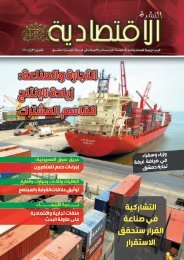SIGAR
2017-01-30qr
2017-01-30qr
Create successful ePaper yourself
Turn your PDF publications into a flip-book with our unique Google optimized e-Paper software.
ECONOMIC AND SOCIAL DEVELOPMENT<br />
and anti-subsidies. ATAR also supported the Ministries of Commerce and<br />
Industry (MOCI), Agriculture, Irrigation, and Livestock (MAIL), and Public<br />
Health (MOPH) in developing procedures and regulations to implement<br />
trade laws that have already been enacted. In addition, ATAR is providing<br />
technical support to parliament as it considers three WTO-required<br />
intellectual-property-rights conventions—the Madrid Protocol, the Paris<br />
Convention, and the Singapore Treaty. 615<br />
While no specific progress in modernizing Afghanistan’s customs administration<br />
was reported this quarter, ATAR facilitated Afghan industry access<br />
to regional markets. It helped about 60 Afghan exporters participate in the<br />
annual India International Trade Fair; helped promote high-end Afghan<br />
products at an exhibition in the UAE; and worked to organize participation<br />
of 10 Afghan marble producers at India Stone Mart 2017 in February. 616<br />
BANKING AND FINANCE<br />
The World Bank said Afghanistan’s financial sector is challenged by the<br />
country’s security environment 617 and remains vulnerable with what the<br />
IMF called “lingering governance concerns, deteriorating asset quality,<br />
and weak profitability.” 618 The banking sector is dominated by 15 banks—<br />
three state-owned, nine private-sector-owned, and three foreign-owned<br />
branch banks. 619 However, public confidence has not been fully restored<br />
in the wake of the 2010 Kabul Bank crisis. Use of bank financing remains<br />
low with an average loan-to-deposit ratio of 19.2%. For Afghanistan’s<br />
three state-owned banks, that ratio was only 4.6% at the end of 2015. 620<br />
In comparison, Pakistan’s commercial loan-to-deposit ratio was 58.7%<br />
and India’s was 78.7% (January 2016); the United States’ was 107.3%<br />
(February 2016). 621<br />
According to the IMF, state-owned banks remain strategically and operationally<br />
deficient, contributing to significant fiscal risk. While the fiscal<br />
positions of these banks are improving, IMF staff noted that Afghanistan<br />
must urgently implement a public-policy framework for them, including<br />
enhanced governance and regulatory enforcement. 622<br />
In October 2016, the World Bank reported that the quality of commercial<br />
and state-owned bank assets continued to deteriorate in the first half of<br />
2016. Commercial-bank loans to the private sector were valued at $740 million<br />
in June 2016, about 8.5% higher than in December 2015. Most loans<br />
were U.S. dollar-denominated, largely due to the effect of afghani currency<br />
depreciation that inflated the value of assets held by commercial banks.<br />
Net profits of the banking sector increased by AFN 4 billion (about<br />
$60 million in current dollars) from the same period last year, but were<br />
derived primarily from customer banking fees. 623 The World Bank previously<br />
attributed Afghanistan’s weak commercial lending to its overall<br />
economic slowdown, low investor confidence, stricter implementations of<br />
156<br />
SPECIAL INSPECTOR GENERAL I AFGHANISTAN RECONSTRUCTION







